3 Agile Project Management Templates to Maximize Team Workflows

You’ve probably heard of Agile by now.
It’s the famous startup based move-fast-and-break-stuff ethos, which has trickled its way into the largest of institutions. Digital transformations orient around the need for speed and maximizing productivity. On the ground level, Agile’s goal is to reduce friction in the lifecycle of a task, thus facilitating an iterative approach towards a successful end goal.
Organizations of all sizes will huddle around project management solutions such as Nifty to help streamline and standardize their workflow processes.
👉 Want instant access to Agile Project Management Templates? Click here to get started with your agile templates today.
Before we dive into the different agile templates you can use as layouts for your projects, let’s cover some of the verbiage to maximize understanding.
Agile Project Management Components
Milestones : Milestones cap off a workflow to effectively bundle a group of tasks. There are many different ways Milestones can be used, and this blog will address a few ideas as to how to incorporate them into your workflow.
Statuses : Statuses are lists within your project that tasks exist within. Your projects will offer a To Do status by default (which can be renamed if you’d like) as well as a Completed Status. We’ll discuss different statuses that can exist in-between these two out-of-the-box lists.
Agile Project Management Template 1: Two-week Sprints
This template is great for Product, Marketing, and Development teams.

Recurring parameters are set for bi-weekly Milestone sprints
This agile project management template will use Milestones as two-week sprints to bundle and measure the completion of all of the tasks based within each sprint. Milestones can be set to recur on a bi-weekly basis so that the next sprint is created automatically. Marketing teams may revise the two-week sprint into a monthly milestone to indicate the progress month’s marketing calendar.

Statuses in this template will be Backlog, To Do, In Progress, Review, and Completed. Tasks can sit in the Backlog section until they are tied to a Milestone (thus selected for the sprint), at which point they’re moved into To Do to start the funnel.
Agile Project Management Template 2: Scope-based Milestones
This template is great for product development teams and client-facing teams

Dependencies link Milestones to maintain project structure and workflow process
For this template, Milestones emphasize the completion of a phase rather than a completion of time. This phase might be a feature push, an event, or a client deliverable. Connecting these Milestones with dependencies will maintain the project’s relative structure if delivery dates are adjusted at any point.

The Review and Client Review lists have people assigned to them to automate task assignments and notification triggers
The Statuses in this template are similar, though a second Review Status might be created for Client Review for teams who are leveraging Nifty to formalize the approval process of their deliverables with their clients. Teams might also elect to ditch the Backlog Status here as they’ve pre-planned which phase these tasks will belong to.
Agile Project Management Template 3: High-velocity Tasks
This template is great for Sales and Ticketing teams
While it’s encouraged to use Milestones when possible to add context to daily tasks in order to prevent employee burnout by feeling that they’re on a never-ending productivity hamster wheel, some high-velocity workflows might not require Milestones, such as sales or ticketing workflows. Milestones may still find their use, such as which bugs will be updated in a single push, or who has ownership over a grouping of sales targets, these Milestones are situational and don’t steer the workflow.

Statuses in this template are going to vary based on the type of Workflow. Sales might see Statuses such as Warm, Hot, Proposal, Lost and Completed (which we’ll use as Closed). Bug Tracking might see Reported, In Progress, QA, Approved, Completed (which we’ll use to indicate that the update has been pushed.
In Summary
Building project structures based on how your team currently or aspires to work is what allows them to be productive while proactively answering questions of task statuses and progress reporting. Don’t forget, if you build a workflow that you absolutely love, you can save it as a template for future use!
Ready to implement Agile in your workflow?
Get Nifty. It’s free to try. Sign up 🚀





